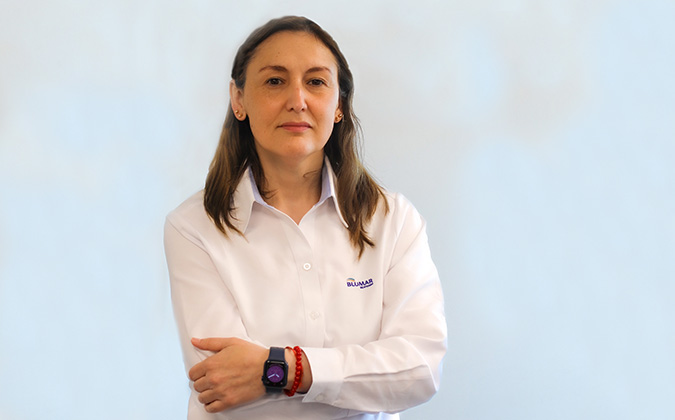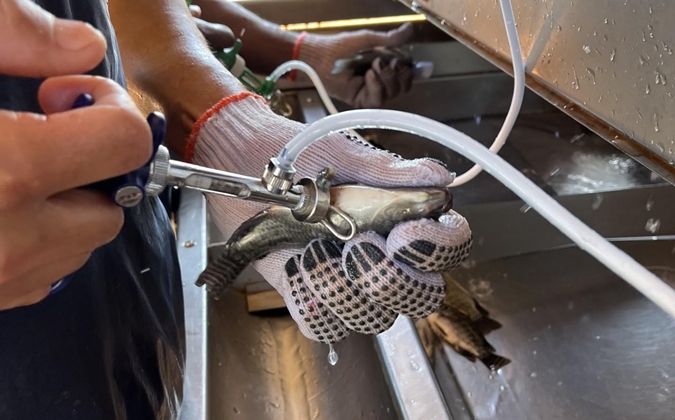
Fish Farm Forum is pleased to host this editorial page on behalf of Pharmaq.
Pharmaq
Vaccines and smart sea lice control helping Chilean salmon giant improve sustainability
This article includes information about authorized veterinary medicines and is intended for professional fish health personnel only.
Salmon rickettsial septicemia (SRS) and Caligus sea lice are two of the major concerns affecting salmon production in Chile. Thanks to new approaches in fish-health management, Blumar Seafoods is successfully limiting their impact, according to Daniela Vargas, MVZ, health manager for the company.
“It has been an integrated strategy, associated with reducing stress factors and improvements in growing conditions, including lower farm densities, which allows the development of better immunity through more efficient vaccines. Everything is monitored through a pen-by-pen surveillance strategy, with early diagnoses and interventions at each unit,” Vargas said.
Productivity parameters in the Chilean salmon industry, such as growth, have improved during the last few years. At the same time, SRS showed a reduction until 2018 but continued to be one of the most important causes of mortality for fish.1 There are companies that have achieved better control of the outbreaks with strategies that involved production and sanitary measures, while also considering animal welfare.
Vaccine’s timely entry helps tame SRS
The reduction of impact seen from the disease has coincided with the introduction of PHARMAQ Alpha Ject® LiVac SRS into the market. Blumar has been using the product since 2018, she said, while making itself available for field testing of new vaccines.
“All our fish are vaccinated, more than just complying with regulation, in the search for the best preventive tools. We were the first company to use a live-attenuated SRS vaccine at one of our sea sites, which offered us greater protection and a different approach to control the disease.”
Remarkable results have been seen on the company’s sites since the vaccine was included as part of the disease-management strategy.
“We have seen continuous improvement in production and health results over time, achieving historical conversion results associated with good-health indicators, SRS mortality levels of less than 2%, plus reduced use of antibiotics,” she explained.
Toward antibiotic-free salmon
Chilean aquaculture has been associated with excessive use of antibiotics.2 Although large cuts in their use have been seen in recent years, further improvements are needed. Blumar is now achieving nearly 40% below the industry average in antibiotic use, Vargas said, with progress reaching a point where it is now producing a range of fully antibiotic-free salmon products. Ultimately, the company’s objective is antibiotic-free production across the board, with specific targets for each region.
“Since 2017, the company has progressively reduced the annual consumption of antibiotics on the farms, achieving a 57% reduction by the end of 2021, based on 2017 data. Compared to 2020, that’s a decrease of 38.3% in grams of pure drug per ton produced in Atlantic salmon,” she noted.
“We have defined production strategies that allow us to increase the production of ‘antibiotic-free’ products, with the fish never being treated with antibiotics, neither in fresh or sea water, which enhances our Laguna Blanca antibiotic-free brand.”
In addition, four other farms were certified antimicrobial-free by the Program for the Optimization of Antibiotic Use in 2021: two Atlantic salmon farms in Magallanes and two farms in Aysén. Of the latter sites, one is for Atlantic salmon, which is known to be hard to achieve in that particular region.
Tackling sea lice
A more recent addition to the firm’s package of fish-health measures is Alpha Flux® — a parasiticide product against Caligus sea lice from PHARMAQ, based on the chemical hexaflumuron. It works as a chitin inhibitor, which means that juvenile lice cannot successfully molt through to adulthood. Other options to treat sea lice cause the parasites to detach, but they can reattach without further action from producers.
The main species of sea lice affecting Chilean salmon production is Caligus rogercresseyi, and high infestation levels can cause reductions in production efficiency, welfare issues and potential susceptibility to other health conditions. Notably, high numbers of lice and repeated bath treatments have been linked to increased severity of SRS.3
Vargas stressed the importance of monitoring parasites and pathogens on sites, to understand the best treatment response.
“In the case of Caligus, we have incorporated preventive pharmacological tools that have substantially reduced antiparasitic baths per cycle and incorporated highly effective products,” she said.
Chilean aquaculture’s evolving picture
The partnership with PHARMAQ is not limited to the supply of treatment options — and she noted the importance of a broader package of support to keep on top of rapidly evolving disease and environmental issues affecting farms on Chile’s Pacific coast.
“It is important to monitor the results of the products in the field, with permanent technical assistance that allows for deviations to be identified, and early detection of changes that raise alerts. Vaccines must also be updated to be increasingly efficient in disease prevention,” she explained.
Strategies to improve the health of farmed fish do not work without consideration of wider factors — and Vargas highlighted the complications that are arising as a result of anthropogenic shifts in climate.
“The changes caused by climate change in temperature, precipitation, ocean acidification, the incidence and extent of oxygen-level drops, among other effects, will have short-, medium- and long-term impacts on the aquaculture sector, increasing the risk of diseases, parasites and harmful algal blooms. This leads to the continuous search for solutions,” she added.
1 Aquabench – Commercial correspondence.
2 Lozano-Muñoz I, Wacyk J, Kretschmer C, Vásquez-Martínez Y, Cortez-San Martin M. Antimicrobial resistance in Chilean marine-farmed salmon: Improving food safety through one health. One Health. 2021;12:100219.
3 Meyer A, Burroughs A, Sadler R, Happold J, Cowled B, Mackenzie C, Lagno ALG, Cameron A. Quantifying the effects of sea lice burden and lice bathing treatments on salmonid rickettsial septicaemia in commercial salmon and trout farms in Chile. Aquaculture. 2019;513:734411.
Posted on: August 11, 2022







